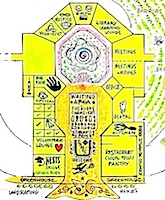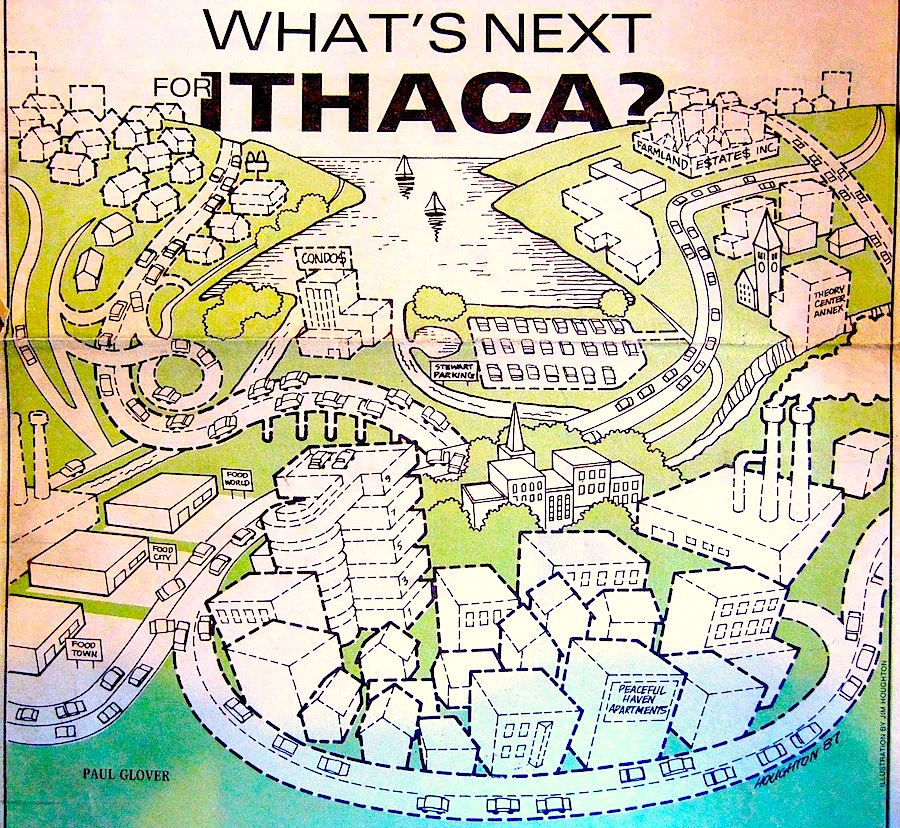






 |
 |
 |
 |
 |
  |
| PAUL
GLOVER ESSAYS: community
control of food, fuel, housing, health care,
planning, education, finance. |
| HOME | INTRO | CURRENCY | SUCCESSES | HOW-TO BOOK | PUBLICITY | ESSAYS |
 |
|
What's Next
for Ithaca? by Paul Glover
* The
Grapevine Weekly * September 1987
Growth is a good thing, up to about seven feet tall, then it starts to get inconvenient. People eight feet tall bang their heads, their backs ache, their circulation slows, they spend more for food and clothes, and when they fall it really hurts. Who can they make love to? The same is true of cities. After a certain size they get more frustrating than exciting: People collide and anger turns to crime. Streets become dangerous, housing costs more, tax rates rise, schools teach less, structures dwarf people, air smells stale, water fouls and traffic slows no matter how wide the roads. As big city life gets ugly, people run away. Crowds escape cities by crowding smaller towns. Which brings us to Ithaca. Dramatic natural boundaries and 200 years of enterprise have made this place distinct and exciting, a rare happy region to live in. But we've begun to get uncomfortably tall. Measure this by: traffic and garbage, the fastest home price rises in New York state (April-July 1987), the highest rents in the Finger Lakes Region, the highest New York state population growth rate (7.5%) this decade, the highest New York state crime rate outside New York City, one of the highest high school dropout rates in the state, looming blank high-rises, contaminated groundwater and Cayuga fish officially unfit to eat. Some say we are progressing nicely. They believe 90,000 county residents earning $1 billion yearly is good business but not yet enough. Neither are 32,000 homes sending 46,000 cars onto 1,250 miles of roads enough. Nor are 2,500 convicted speeders yearly, 900 traffic injuries and 12 auto deaths yearly apparently enough. The end of the New york state natural gas surplus in 12 years (1985 NYS Power Pool Report) does not bother boosters. The worst fuel crisis yet, two or three years ahead, according to the Department of the Interior (Time, 3/16/87), is not their concern either. Despite our 85% dependence on out-of-state food, further conversion of local orchards and farmland into suburbs proceeds, as American as concrete pie. Taxes Nevertheless, we are told that suburbanization, taller buildings and wider highways are necessary and inevitable. We are told we must sprawl endlessly to broaden the tax base, punging ahead to keep taxes down. Not so. The Town of Ithaca's tax rate rose 42% in the past five years. The City of Ithaca's budget rose 19% since last year. The boom is busting us. Why? San Francisco and Los Angeles voters approved tough commercial development restrictions last year. San Francisco ballot organizer Sue Hestor eplained, "People have been told that this growth, the higher densities, is good for them, good for jobs and the city's economy. But I think they've realized they've been sold a bill of goods, that the profits are taken out by the developers and the costs are borne by the residents." DeKalb County, Illinois and Loudoun County, Virginia, found that new suburbs paid only 70% of the costs of new schools, roads, police, fire protection, sewer and water lines. That's profit for developers and burden for the public. Studies in Denver and Palo Alto found that govenment needs to charge developers nearly half the selling price of a new home-- in addition to regular taxes-- just to pay for additional public services. Jobs More jobs though, they say, come only from more and more. These jobs, however, are not for us, but for people elsewhere who come to compete for low wages. A large part of local manufacturing jobs are already held by commuters from beyond Tompkins County. Such jobs usually stimulate only 1.2 low-paid service jobs each. No real gain for local kids. Blacks particularly do not benefit from this competition. Ten years of Sunbelt industrialization have not lifted blacks from poverty, according to both Julian Bond and Fortune magazine. A Community Development document expects that the likeliest industries to locate in this city would offer "under 33%" of jobs to women and would pay a "very low-medium" wage. At the same time, boomtown prices rise, hurting workers more. There are better ways to create better jobs for all of us here. Construction trades can prosper by erecting heavily insulated earth-sheltered solar co-op transit-reliant cluster apartments in the urban core. More laborers would be needed to rebuild Ithaca for future conditions than to extend it. There's plenty of other environmentally useful labor to be done. New commerical and residential development can be required, as elsewhere, to hire local people for construciton and for new jobs they create.The Self-Reliance Center's LETSystem (Local Economic Trading System) fosters local small business by connecting services to needs. The AGORA Project also seeks seed money for new small enterpise. More basically, Cornell needs to be pressured by all area governemnts and agencies, for the good of the whole community, to pay decent wages. Existing jobs need to be protected through plant closing legislation. Housing Housing is not necessarily made cheaper by building more of it. During the past four years merely some 20 new low-income units have been added citywide (eight by INHS and 12 at Eddygate), while rising rents have made llfe harder for hundreds. Only two things will create affordable housing for thousands who need it. The City and Town of Ithaca should pressure Cornell to house the second half of its students on campus, and the city espceially should enact rent control in all partments held by owners of three or more. As well, home heating now burns twice the amount of the household budget that it consumed in 1960, adjusted for inflation. Heavy subsidies for superinsulation should top our list. Highways Every importatnt town wants fast roads crossing it, boosters say. Don't highways make life safer and easier and bring more money? Again, not so. The most dangerous intersection in Tompkins County is the overpass at Triphammer and Route 13, and the city's traffic injuries are concentrated along Meadow Street (Rte. 13). especially at the Dey Street intersection. Traffic swells up so much at rush hour and is increasing at such a rate that some days it crawls like the old two-lane route. Planners already talk of removing parking from Seneca and Geneva streets, to handle traffic were a new Rte. 96 built. The choice today is to make this treadmill even bigger (proposal to make Meadow Street one-way northbound, with Fulton Street widened one-way southbound), or to embrace foot, bike, rail or bus transit. Major roads favor major market outsiders (Pyramid, Tops, Wegmans) who overpower small locally-owned businesses. New developments like Wegmans should at least pay traffic impact fees and transit improvement assessments. Sprawl Controls Despite what politicians say, sprawl is not inevitable. About 1,500 American communities are tough on sprawl, using dozens of legal controls stronger than conventional zoning. Just as public health laws limit occupancy of theaters and elevators, courts increasingly help stop overcrowding of valleys and hills. There are development limit lines, speculation penalties, building permit limits, urban-rural service |
assessments,
performance zoning, cluster zoning, purchase of
development rights, conservation easements; exactions from developpers
to fund greenbelts, daycare, festivals and to compensate for
downzoning; referenda for all variance petitions and more. Most can be
used here. Inventing the Future When their arguments lay dead, boosters will tell us "You're selfish. You've got a good thing here so you want to put a wall around it." Selfish and proud, yes, in the best way. We have a moral oligation to keep greater Ithaca coherent and safe to live in, to pass it to the next generations in good condition. We have a responsibility to set examples with better ideas, rather than become another victim of sprawl. We are obliged to our children and grandchildren to make Ithaca cleaner, more colorful, more fragrant and fruitful. Our responsibility is to create jobs and housing which improve rather than degrade us. At the same time, we need to prepare for a future of fuel shortage in which the highest use of land will be to prouce clear water, fresh air and a regional food supply. Some realtors and developers would damage these opportunities, for selfish gain. During the next few years, every Ithacan will help decide whether Ithaca is gorges, or suburbs. Hereafter, neighborhoods can design their own futures. When united, neighborhod councils can demand that City Hall either help or get out of the way. They can enable citizens, through small, informal gatherings, to map what they want to protect and what they want to build or change. Some neighborhoods, for example, have converted streets to parks or bikeways, installed benches and fruit trees, revived the small grocery or social center, laid mosaic sidewals, started barter and loan systems, newsletters, daycare services and even banks. There are neighorhoods which cut taxes and fund programs through contracting to perform city services. Creative possibilities are endless. Such ideas brought to larger gatherings will be the basis for a revised General Plan, itself the basis for new zoning and land use regulations. We are an outstandingly talented people. This region will benefit by our knowledge and enthusiasm, brought from the wide world to serve local virtues. Whether you were born here or just arrived, welcome to Ithaca. Our efforts are a gift to the next million who will enjoy Tompkins County, 90,000 at a time. The Self-Reliance Center's LETSystem (Local Economic Trading System) fosters local small business by connecting services to needs. The AGORA Project also seeks seed money for new small enterpise. More basically, Cornell needs to be pressured by all area governemnts and agencies, for the good of the whole community, to pay decent wages. Existing jobs need to be protected through plant closing legislation. Housing Housing is not necessarily made cheaper by building more of it. During the past four years merely some 20 new low-income units have been added citywide (eight by INHS and 12 at Eddygate), while rising rents have made llfe harder for hundreds. Only two things will create affordable housing for thousands who need it. The City and Town of Ithaca should pressure Cornell to house the second half of its students on campus, and the city espceially should enact rent control in all partments held by owners of three or more. As well, home heating now burns twice the amount of the household budget that it consumed in 1960, adjusted for inflation. Heavy subsidies for superinsulation should top our list. Highways Every importatnt town wants fast roads crossing it, boosters say. Don't highways make life safer and easier and bring more money? Again, not so. The most dangerous intersection in Tompkins County is the overpass at Triphammer and Route 13, and the city's traffic injuries are concentrated along Meadow Street (Rte. 13). especially at the Dey Street intersection. Traffic swells up so much at rush hour and is increasing at such a rate that some days it crawls like the old two-lane route. Planners already talk of removing parking from Seneca and Geneva streets, to handle traffic were a new Rte. 96 built. The choice today is to make this treadmill even bigger (proposal to make Meadow Street one-way northbound, with Fulton Street widened one-way southbound), or to embrace foot, bike, rail or bus transit. Major roads favor major market outsiders (Pyramid, Tops, Wegmans) who overpower small locally-owned businesses. New developments like Wegmans should at least pay traffic impact fees and transit improvement assessments. Sprawl Controls Despite what politicians say, sprawl is not inevitable. About 1,500 American communities are tough on sprawl, using dozens of legal controls stronger than conventional zoning. Just as public health laws limit occupancy of theaters and elevators, courts increasingly help stop overcrowding of valleys and hills. There are development limit lines, speculation penalties, building permit limits, urban-rural service assessments, performance zoning, cluster zoning, purchase of development rights, conservation easements; exactions from developpers to fund greenbelts, daycare, festivals and to compensate for downzoning; referenda for all variance petitions and more. Most can be used here. Inventing the Future When their arguments lay dead, boosters will tell us "You're selfish. You've got a good thing here so you want to put a wall around it." Selfish and proud, yes, in the best way. We have a moral oligation to keep greater Ithaca coherent and safe to live in, to pass it to the next generations in good condition. We have a responsibility to set examples with better ideas, rather than become another victim of sprawl. We are obliged to our children and grandchildren to make Ithaca cleaner, more colorful, more fragrant and fruitful. Our responsibility is to create jobs and housing which improve rather than degrade us. At the same time, we need to prepare for a future of fuel shortage in which the highest use of land will be to prouce clear water, fresh air and a regional food supply. Some realtors and developers would damage these opportunities, for selfish gain. During the next few years, every Ithacan will help decide whether Ithaca is gorges, or suburbs. Hereafter, neighborhoods can design their own futures. When united, neighborhod councils can demand that City Hall either help or get out of the way. They can enable citizens, through small, informal gatherings, to map what they want to protect and what they want to build or change. Some neighborhoods, for example, have converted streets to parks or bikeways, installed benches and fruit trees, revived the small grocery or social center, laid mosaic sidewals, started barter and loan systems, newsletters, daycare services and even banks. There are neighorhoods which cut taxes and fund programs through contracting to perform city services. Creative possibilities are endless. Such ideas brought to larger gatherings will be the basis for a revised General Plan, itself the basis for new zoning and land use regulations. We are an outstandingly talented people. This region will benefit by our knowledge and enthusiasm, brought from the wide world to serve local virtues. Whether you were born here or just arrived, welcome to Ithaca. Our efforts are a gift to the next million who will enjoy Tompkins County, 90,000 at a time. [email protected] |
| HOME | INTRO | CURRENCY | SUCCESSES | HOW-TO BOOK | PUBLICITY | ESSAYS BY GLOVER |
 |